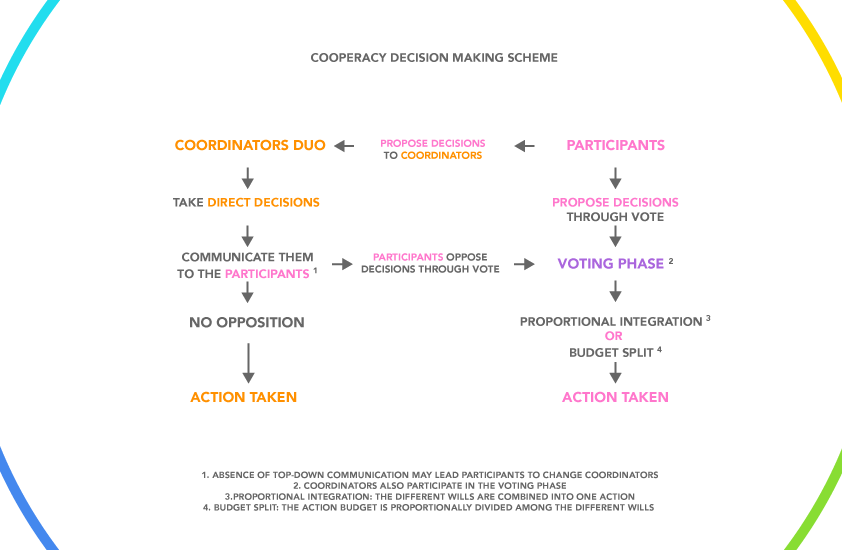
The Cooperacy governance is the way participants take decisions in Cooperacy, according to cooperation science insights.
COOPERATIONS
The Cooperacy governance is made of cooperations, that can also be
containers. The main cooperation container is Cooperacy itself. Every
cooperation is based on the most simple form of
cooperation: two
or more people doing something together.
It is advised every cooperation should have two coordinators and a maximum
of 150 people. They may also decide to elect everyone as coordinator to
experiment diffuse governance.
Anytime, coordinators may resign, can be substituted upon the cooperation
participants’ will or candidates may propose themselves to become
coordinators.
DECISIONS
Coordinators may take direct decisions in their cooperation. Only when
their decision is publicly communicated it becomes effective. When they
are in contrast or unsure about what decision to take, coordinators can
ask advice to the participants or start a voting phase, remembering voting
is never subject to majority but represents an official evaluation that
needs to be
integrated.
Participants can propose decisions as well through voting evaluation or
asking the coordinators for direct approval.
Participants may also oppose the coordinators decisions. If the opposing
participants are at least two1, the coordinators should
proportionally and creatively
integrate the
opposition according to the seven
solutions
or alternatively start a voting evaluation.
If just a single participant proposes or opposes, but nobody secondes, the
single instance is recorded or, when possible, but not always,
proportionally and creatively
integrated.

VOTING EVALUATIONS
Cooperacy is a design democracy: we vote cooperation ideas first, people
afterwards. Decisions are voted independently from the people who will
enact them, as they will be chosen on a second step.
The voting can be anonymous during the voting phase, but becomes
transparent once the results are shown. All voting evaluation results are
transparent.
The decision making is based on approval voting, that is, everyone may
vote with a single vote all the cooperation ideas or alternative decisions
they want. If there is not a clear orientation2 after the
voting evaluation, the participants may want to leave their choice to the
coordinators. They may also choose with the coordinators which one of the
seven possible
solutions
to apply for the realization of the cooperation’s will.
1: DUAL COORDINATION The idea of a coordinating pair came up in order to
avoid power to be concentrated in just one person, that receives huge
responsibilities and is alone in facing them, or in more than two people,
that may generate internal conflictual groups or collusions. Collective
coordination is also possible, although roles could emerge anyways.
2: VOTING IS INFORMATIVE The voting results are indicators of the
participants will, they do not explicitly determine a final decision,
because winning and losing the voting process is substituted by evaluation
and
proportional creative integration.